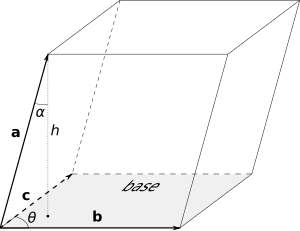त्रिक गुणनफल
नेविगेशन पर जाएँ
खोज पर जाएँ
The printable version is no longer supported and may have rendering errors. Please update your browser bookmarks and please use the default browser print function instead.
सदिश बीजगणित में तीन ३-विमीय सदिशों का गुननफल त्रिक गुणनफल (triple product) कहलाता है। दो तरह के त्रिक गुणनफल होते हैं- अदिश मान वाला त्रिक गुणनफल तथा सदिश त्रिक गुणनफल।
अदिश त्रिक गुणनफल
- <math>{a}\cdot({b}\times{c}) = {c}\cdot({a}\times{b}) = {b}\cdot({c}\times{a})</math>
इस गुणन्फल का मान तीनों सदिशों <math>\mathbf{a}</math>, <math>\mathbf{b}</math> और <math>\mathbf{c}</math> से बने हुए समान्तरषटफलक के आयतन के बराबर होता है।
गुण
- चक्रीय शिफ्ट करने पर अदिश त्रिक गुणनफल (a, b, c) का मान नहीं बदलता। :
- <math>
\mathbf{a}\cdot(\mathbf{b}\times \mathbf{c})=
\mathbf{b}\cdot(\mathbf{c}\times \mathbf{a}) =
\mathbf{c}\cdot(\mathbf{a}\times \mathbf{b})
</math>
- Swapping the positions of the operators without re-ordering the operands leaves the triple product unchanged. This follows from the preceding property and the commutative property of the dot product.
- <math>
\mathbf{a}\cdot (\mathbf{b}\times \mathbf{c}) \equiv
(\mathbf{a}\times \mathbf{b})\cdot \mathbf{c}
</math>
- Swapping any two of the three operands negates the triple product. This follows from the circular-shift property and the anticommutativity of the cross product.
- <math>\begin{align}
&\mathbf{a}\cdot(\mathbf{b}\times \mathbf{c}) \\
\equiv -&\mathbf{a}\cdot(\mathbf{c}\times \mathbf{b}) \\
\equiv -&\mathbf{b}\cdot(\mathbf{a}\times \mathbf{c}) \\
\equiv -&\mathbf{c}\cdot(\mathbf{b}\times \mathbf{a})
\end{align}</math>
- The scalar triple product can also be understood as the determinant of the साँचा:gaps matrix (thus also its inverse) having the three vectors either as its rows or its columns (a matrix has the same determinant as its transpose):
- <math>\mathbf{a}\cdot(\mathbf{b}\times \mathbf{c}) \equiv \det \begin{bmatrix}
a_1 & a_2 & a_3 \\ b_1 & b_2 & b_3 \\ c_1 & c_2 & c_3 \\
\end{bmatrix}={\rm det}\left(\mathbf{a},\mathbf{b},\mathbf{c}\right) .</math>
- If the scalar triple product is equal to zero, then the three vectors a, b, and c are coplanar, since the parallelepiped defined by them would be flat and have no volume.
- If any two vectors in the triple scalar product are equal, then its value is zero:
- <math>
\mathbf{a} \cdot (\mathbf{a} \times \mathbf{b}) \equiv
\mathbf{a} \cdot (\mathbf{b} \times \mathbf{a}) \equiv
\mathbf{a} \cdot (\mathbf{b} \times \mathbf{b}) \equiv
\mathbf{a} \cdot (\mathbf{a} \times \mathbf{a}) \equiv 0
</math>
- Moreover,
- <math>
[\mathbf{a}\cdot(\mathbf{b}\times \mathbf{c})] \mathbf{a} \equiv
(\mathbf{a}\times \mathbf{b})\times (\mathbf{a}\times \mathbf{c})
</math>
- The simple product of two triple products (or the square of a triple product), may be expanded in terms of dot products:[१]साँचा:paragraph breakसाँचा:glossaryसाँचा:defnसाँचा:glossary endसाँचा:paragraph breakThis restates in vector notation that the product of the determinants of two 3×3 matrices equals the determinant of their matrix product.
सदिश त्रिक गुणनफल
यह गुणनफल एक सदिश राशि होती है।
- a*(b*c)=(a.c)b-(a.b)c
